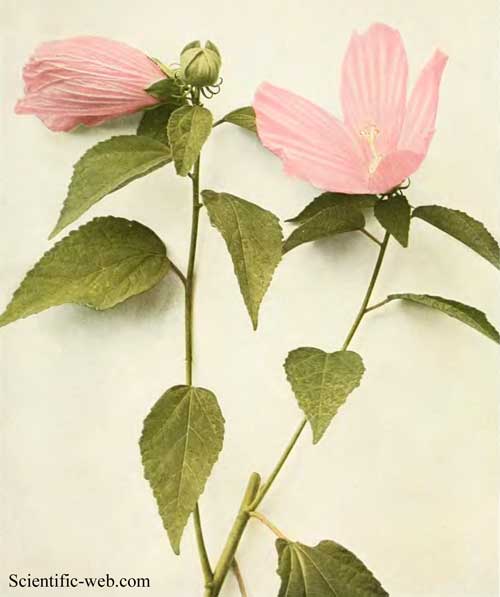
Hybiscus moscheutos
Classification System: APG IV
Superregnum: Eukaryota
Regnum: Plantae
Cladus: Angiosperms
Cladus: Eudicots
Cladus: Core eudicots
Cladus: Rosids
Cladus: Eurosids II
Ordo: Malvales
Familia: Malvaceae
Subfamilia: Malvoideae
Tribus: Hibisceae
Genus: Hibiscus
Sectio: H. sect. Muenchhusia
Species: Hibiscus moscheutos
Name
Hibiscus moscheutos L., 1753.
Typus: Without data (lectotype: LINN 875.1). Lectotypified by Reveal, in C. E. Jarvis, Order out of Chaos 570. 2007.
Synonyms
Homotypic
Hibiscus petioliflorus Stokes, Bot. Mat. Med. 3: 543. 1812, nom. illeg.
Heterotypic
Abelmoschus palustris Walp., Repert. Bot. Syst. (Walpers) 1: 311. 1842.
Abelmoschus roseus Walp., Repert. Bot. Syst. (Walpers) 1: 311. 1842.
Hibiscus californicus Kell., Proc. Calif. Acad. Sci. 4: 292. 1873.
Hibiscus incanus J.C.Wendl., Bot. Beob. 54. 1798.
Hibiscus langloisii Greene, Leafl. Bot. Observ. Crit. 2: 67. 1910.
Hibiscus lasiocarpos Cav., Diss. 3: 159, t. 70(1). 1787.
Hibiscus lasiocarpos var. californicus (Kell.) L.H.Bailey, Stand. Cycl. Hort. 1486. 1915.
Hibiscus lasiocarpos var. occidentalis (Torr.) A.Gray, Proc. Amer. Acad. Arts 22: 303. 1887.
Hibiscus leucophyllus Shiller, Southw. Naturalist 5: 170. 1960.
Hibiscus moscheutos f. peckii House, Bull. New York State Mus. 243/244: 54. 1923.
Hibiscus moscheutos subsp. incanus (J.C.Wendl.) Ahles, J. Elisha Mitchell Sci. Soc. 80: 173. 1964.
Hibiscus moscheutos subsp. lasiocarpos (Cav.) O.J.Blanchard, Novon 18: 4. 2008.
Hibiscus moscheutos subsp. palustris (L.) R.T.Clausen, Mem. Cornell Univ. Agric. Exp. Sta. 291: 8. 1949.
Hibiscus moscheutos var. flavescens Alph.Wood, Class-book Bot. (ed. 1861). 270. 1861.
Hibiscus moscheutos var. lasiocarpos (Cav.) B.L.Turner, Phytologia 90(3): 379. 2008.
Hibiscus moscheutos var. occidentalis Torr., U.S. Expl. Exped., Phan. Pacific N. Amer. 17(2): 256. 1874.
Hibiscus oculiroseus Britton, J. New York Bot. Gard. 4: 220, pl. 18. 1903.
Hibiscus opulifolius Greene, Leafl. Bot. Observ. Crit. 2: 65. 1910.
Hibiscus palustris L., Sp. Pl. 693. 1753.
Hibiscus palustris Thore, Chlor. Land. 295., nom. illeg. non L. (1753).
Hibiscus palustris f. oculiroseus (Britton) Fernald, Rhodora 41: 112. 1939.
Hibiscus palustris f. peckii (House) House, Bull. New York State Mus. 254: 490. 1924.
Hibiscus pinetorum Greene, Leafl. Bot. Observ. Crit. 2: 66. 1910.
Hibiscus platanoides Greene, Leafl. Bot. Observ. Crit. 2: 66. 1910.
Hibiscus roseus Thore, Fl. Gall. (Loisel.) ed. 1. 2: 434.
References
Linnaeus, C. 1753. Species Plantarum 2:693.
USDA, ARS, Germplasm Resources Information Network. Hibiscus moscheutos in the Germplasm Resources Information Network (GRIN), U.S. Department of Agriculture Agricultural Research Service. Accessed: 07-Oct-06.
Vernacular names
Deutsch: Sumpfeibisch
English: Crimsoneyes rosemallow, swamp rosemallow
Hibiscus moscheutos, the rose mallow, swamp rose-mallow,[2] crimsoneyed rosemallow,[3] or eastern rosemallow,[1] is a species of flowering plant in the family Malvaceae. It is a cold-hardy perennial wetland plant that can grow in large colonies. The hirsute leaves are of variable morphology, but are commonly deltoidal in shape with up to three lobes. It is found in wetlands and along the riverine systems of the eastern United States from Texas to the Atlantic states, its territory extending northward to southern Ontario.
Numerous forms exist in nature. Petal colors range from pure white to deep rose, and most have an eye of deep maroon. Taxonomic consensus is lacking for the nomenclature of the multiple subspecies. The flowers are borne apically, whereas the related Hibiscus laevis carries bud and bloom along the stem.
Ecology
It is a larval host for the common checkered skipper, the gray hairstreak, the Io moth, and the pearly wood nymph.[4]
Cultivation
This is a popular garden plant. It can be propagated by seed, or by crown divisions during winter dormancy, and some success can be achieved by hard-wood stem cuttings. Numerous hybrids of the native North American Hibiscus species have been released by the commercial nursery trade. In cultivation the species or the hybrids can be used in bog gardens or other water features. They are attractive and have wildlife value for nectar-feeders and birds.
Cultivars
Corolla
Many cold-hardy hibiscus cultivars are hybrids of H. moscheutos, H. palustris, H. coccineus, H. laevis, H. militaris, H. grandiflorus, H. dasycalyx, H. mutabilis. With indeterminate genetic contributions from each parent species.[5] Hibiscus breeders do not preclude the possibility of self-pollination. However, recent research has shown that artificial pollination just after the flower has opened using a high pollen load will ensure that most of the resulting seeds are from the selected pollen parent. Early hibiscus breeders were likely aware of this and used it to their advantage.[6]
Conservation
In Canada this plant is listed as a species of special concern under the Species at Risk Act.[2][7]
Maroon flower
References
"Hibicus moscheutos". NatureServe Explorer. NatureServe. Archived from the original on 2007-09-29. Retrieved 2013-07-04.
COSEWIC 2004. COSEWIC assessment and update status report on the swamp rose-mallow Hibiscus moscheutos in Canada. Committee on the Status of Endangered Wildlife in Canada. Ottawa.
Hibiscus moscheutos. USDA PLANTS.
The Xerces Society (2016), Gardening for Butterflies: How You Can Attract and Protect Beautiful, Beneficial Insects, Timber Press.
Winters, H. F. (1970). Our hardy Hibiscus species as ornamentals. Economic Botany 24(2) 155-64.
Snow, A. A., et al. (2000). Effects of sequential pollination on the success of "fast" and "slow" pollen donors in Hibiscus moscheutos (Malvaceae). American Journal of Botany 87(11) 1656-59.
*Swamp Rose-mallow. Archived 2013-06-10 at the Wayback Machine Environment Canada: Species at Risk Public Registry.
Retrieved from "http://en.wikipedia.org/"
All text is available under the terms of the GNU Free Documentation License

